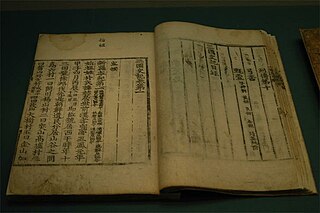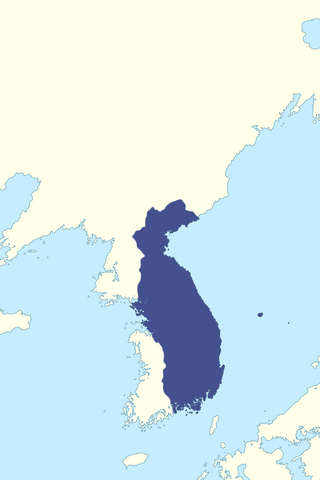
Goguryeo also later known as Goryeo, was a Korean kingdom located in the northern and central parts of the Korean Peninsula and the southern and central parts of modern day Northeast China. At its peak of power, Goguryeo controlled most of the Korean Peninsula, large parts of Manchuria and parts of eastern Mongolia and Inner Mongolia as well as Russia.

Samguk Sagi is a historical record of the Three Kingdoms of Korea: Goguryeo, Baekje and Silla. Completed in 1145, it is well known in Korea as the oldest surviving chronicle of Korean history.

The Three Kingdoms of Korea or Samhan competed for hegemony over the Korean Peninsula during the ancient period of Korean history. During the Three Kingdoms period, many states and statelets consolidated until, after Buyeo was annexed in 494 and Gaya was annexed in 562, only three remained on the Korean Peninsula: Goguryeo, Baekje and Silla. The "Korean Three Kingdoms" contributed to what would become Korea; and the Goguryeo, Baekje and Silla peoples became the Korean people.

Silla, alternatively Shilla, was a Korean kingdom that existed between 57 BCE – 935 CE and located on the southern and central parts of the Korean Peninsula. Silla, along with Baekje and Goguryeo, formed the Three Kingdoms of Korea. Silla had the lowest population of approximately 850,000 people, which was significantly smaller than those of Baekje and Goguryeo.

Munmu of Silla was a Korean monarch who served as the 30th king of the Korean kingdom of Silla. He is usually considered to have been the first ruler of the Unified Silla period. Munmu was the son of King Muyeol and Munmyeong, who was the younger sister of Kim Yu-sin. Under his father's reign, he held the office of pajinchan, who apparently was responsible for maritime affairs, and played a key role in developing the country's diplomatic links with Tang China. He was born Prince Beopmin, and took the name Munmu when he succeeded his father to the throne. After his death, he was known by the title of Dragon King. Munmu is known as one of the great rulers in the land of Korea. During his rule, he tried to achieve the welfare and happiness of the people and to improve the political and social system. He paid great attention to justice and equality and tried to avoid neglecting the people. Munmu also attached great importance to the development of culture and art and tried to promote them in the society. He even paid attention to creating an advanced cultural and educational environment.

Kim Yu-sin was a Korean military general and politician in 7th-century Silla. He led the unification of the Korean Peninsula by Silla under the reign of King Muyeol and King Munmu. He is said to have been the great-grandchild of King Guhae of Geumgwan Gaya, the last ruler of the Geumgwan Gaya state. This would have given him a very high position in the Silla bone rank system, which governed the political and military status that a person could attain.

Unified Silla, or Late Silla, is the name often applied to the Korean kingdom of Silla, one of the Three Kingdoms of Korea, after 668 CE. In the 7th century, a Silla–Tang alliance conquered Baekje in the Baekje–Tang War. Silla conquered the southern part of Goguryeo in the 7th century following the Goguryeo–Tang War and Silla–Tang War, unifying the central and southern regions of the Korean peninsula.

Hubaekje or Later Baekje was one of the Later Three Kingdoms of Korea, along with Taebong and Silla. Later Baekje was a Korean dynastic kingdom founded by the disaffected Silla general Kyon Hwon in 900, whom led the local gentry and populace that were in large Baekje descent holding onto their collective consciousness until the twilight days of Later Silla. With the former Silla general declaring the revival of the Baekje kingdom of old, the Baekje refugees from the old territories and a portion of the Rank Six Nobility from Silla seeking the opportunity of rising up the ranks gathered under his leadership. Led by the charismatic and capable Kyon Hwon who was also a competent field commander, Later Baekje in its early days was advantageous in the power game against the newly found kingdom Goryeo and the declining Silla. However, despite its fertile territories in the Jeolla Province and capable military prowess, it eventually fell to Wang Kon's Goryeo army in 936 due to political strife and Kyon Hwon's defection towards Goryeo. Its capital was at Jeonju, in present-day North Jeolla province.
Buyeo Pung was a prince of Baekje, one of the Three Kingdoms of Korea. He was son of the last king, Uija of Baekje. When Baekje fell to the Silla–Tang alliance in 660, he was a hostage who mortgaged the alliance of Baekje with Japan. He was shortly unofficially proclaimed king.
Geom Mojam (?–670) was the military leader of a short-lived movement to restore Goguryeo after its fall to Silla in the later 7th century CE. After the kingdom fell to Tang and Silla in 668, he kindled an opposition movement in the Taedong River valley and in 670 established Anseung as the new King of Goguryeo. Anseung is believed to have been the illegitimate son of King Bojang, the last ruler of that kingdom. The capital was set up in modern-day Chaeryŏng-gun, South Hwanghae, North Korea. The rebellion is briefly described in the Samguk Sagi, Goguryeo Book 10.
The Protectorate-General to Pacify the East was an administrative division of the Chinese Tang dynasty in Manchuria and the northern part of the Korean Peninsula. It was established after the Tang dynasty defeated Goguryeo and annexed its territories. In the place of Baekje and Goguryeo, the Tang dynasty created the Protectorate General to Pacify the East and the Ungjin Commandery. A proposal to set up the Great Commandery of Gyerim by the Emperor Gaozong of Tang to King Munmu of Silla was refused.
Bojang of Goguryeo was the 28th and last monarch of Goguryeo the northernmost of the Three Kingdoms of Korea. He was placed on the throne by the military leader Yeon Gaesomun. His reign ended when Goguryeo fell to the allied forces of the southern Korean kingdom of Silla and the Chinese Tang dynasty.
Seongdeok Daewang was the thirty-third king of the ancient Korean kingdom of Silla. He was the second son of King Sinmun, and the younger brother of King Hyoso. In 704 Seongdeok married Lady Baeso 陪昭夫人, the daughter of Gim Wontae. In 715 their son, Junggyeong 重慶, was named Crown Prince and heir presumptive. Shortly thereafter, and for reasons unclear but quite likely having to do with a power struggle at court between the king and the clan of the queen, Queen Seongjeong was evicted from the palace in 716. As further evidence of a possible power struggle, the next year Junggyeong died under circumstances that remain unknown. Following the fall from favor of his first wife, King Seongdeog married Sodeok in 720, the daughter of the minister Gim Sun-won. Kings Hyoseong and Gyeongdeok were among the children of Seongdeok and Sodeok.

Sinmun of Silla was the thirty-first king of Silla, a Korean state that originated in the southwestern Korean peninsula and went on to unify most of the peninsula under its rule in the mid 7th century. He was the eldest son of Silla's unifier-king, Munmu and Queen Jaeui. Sinmun's reign may be characterized by his attempts to consolidate royal authority following unification and to reorganize and systematize the governing apparatus of the newly enlarged Silla state.
Kim Inmun (629–694) was a noted aristocrat, scholar, and official of the ancient Korean kingdom of Silla. He was the son of Muyeol and the younger brother of Munmu, the twenty-ninth and thirtieth kings respectively of Silla.
The Goguryeo revival movements were various attempts to revive the Kingdom of Goguryeo after its defeat by the Silla-Tang alliance in 668. After 668, several different revival movements were initiated throughout the former territories of Goguryeo and some even in Tang territory. A new theory among Korean historians states that Gung-ye, the founder of Taebong, was a descendant of Anseung and the Go Dynasty. This theory has not been completely accepted yet, as more research is still in process.
The Goguryeo controversies are disputes between China and Korea on the history of Goguryeo, an ancient kingdom located in present-day Northeast China and the Korean Peninsula. At the heart of the Goguryeo controversy is which part of history the kingdom belongs to. Korean scholars have the viewpoint that Goguryeo is part of Korean history alone.

The Silla–Tang War (670–676) occurred between the Silla kingdom of Korea and the Tang dynasty of China. It began in the geopolitical context immediately following the conquest of Goguryeo and Baekje by the joint forces of Silla and Tang. The conflict ended with a truce between Tang and Silla due to the internal political situation in both states, with the dividing territorial line at the Taedong River basin.
Yeongyang of Goguryeo was the 26th monarch of Goguryeo, the northernmost of the Three Kingdoms of Korea. He was the eldest son of Pyeongwon of Goguryeo. During his reign, Goguryeo defeated multiple invasions by the Sui dynasty.








